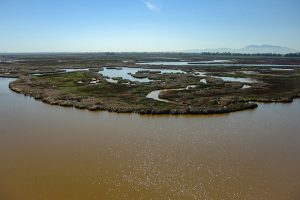Groundwater Management
Legislative and Executive Actions Seek to Address Groundwater Conditions
Last year marked the 10th anniversary of the Sustainable Groundwater Management Act (SGMA). A retrospective of SGMA implementation to this point reveals a bounty of success stories and an overall acknowledgment that the law has worked as intended. The law requires groundwater sustainability agencies (GSAs) in the state’s high- and medium-priority basins to develop and implement groundwater sustainability plans (GSPs), which detail how groundwater basins will be sustainably managed. Each GSP must be approved by the Department of Water Resources (DWR), and as of 2024, the vast majority of plans have been approved. The herculean task of correcting decades of overdraft in many parts of the state will require a holistic approach to groundwater management, including a pronounced focus on strategies to replenish groundwater basins.
Groundwater Recharge
Following extreme drought conditions from 2020 to 2022, California experienced consecutive years of above-normal precipitation, which filled reservoirs and led to a significant reduction in statewide groundwater extraction. Increased surface water supply led to total annual groundwater extractions dropping from 17 million acre-feet in Water Year 2022 to 9.5 million acre-feet in Water Year 2023.
In 2023, as storms were pounding California, Governor Gavin Newsom issued a series of executive orders that suspended permitting requirements so water users could divert floodwaters and recharge groundwater basins without being burdened by regulatory delays. The Legislature codified portions of the executive orders later that year, further enabling the ability of water users to take advantage of high flow events when they existed.
California was able to achieve 4.1 million acre-feet of managed groundwater recharge in Water Year 2023, with approximately 93% of this recharge occurring in the San Joaquin Valley. Under the Governor’s executive orders, more than 400,000 acre-feet of flood waters were recharged. Some water users also took advantage of the state’s temporary urgency permit, which authorizes diversions under certain conditions for 180 days. These permits resulted in more than 660,000 acre-feet of recharge in Water Year 2023. Overall, the state experienced an increase of 8.7 million acre-feet in groundwater storage.
Recharge Legislation
In 2024, as California experienced a second straight wet winter, the Legislature sought to build on its prior recharge efforts.
• AB 2060 (Soria; D-Merced) sought to exempt temporary urgency permits for diversions to underground storage from Lake and Streambed Alteration Agreements (LSAA) requirements if certain conditions were met. While the 180-day temporary urgency permit helps streamline the process of obtaining authorization to divert water not subject to a senior water right, the LSAA process still can result in significant delays and nullify some of the benefits of the permit. AB 2060 passed the Assembly but ultimately died on the Senate floor.
• SB 1390 (Caballero; D-Merced), among other things, sought to address concerns that diversions occurring under the authority granted by the Governor’s executive orders continued even after risks of imminent flooding abated. For example, while the majority of diversions began in March, shortly after the executive orders were issued and many rivers were at or near flood stage, in many cases, diversions continued through August and September. Concerns grew that these diversions were infringing upon water rights of downstream users. Therefore, SB 1390 sought to place additional restrictions on when flood flows could be diverted without a water right. The bill passed the Senate but died on the Assembly floor.
Well Permitting
In 2022, in the midst of emergency drought conditions, Governor Newsom issued two executive orders that, among other things, imposed new requirements for issuing permits for a new groundwater well or the alteration of an existing well in a basin subject to SGMA. Specifically, the local agency responsible for permitting wells was required to obtain written verification from the local GSA that extractions by the proposed well would not be inconsistent with a sustainable groundwater management program in a local GSP and would not decrease the likelihood of achieving a sustainability goal for the basin. The executive order also required the well permitting agency to determine that the proposed well would not likely interfere with nearby wells and would not cause subsidence that would harm infrastructure.
In early 2024, the California Department of Water Resources (DWR) published a report detailing the methods local agencies used to implement the executive orders and the impact they had on well permitting throughout the state. The report concluded that the executive orders enhanced coordination between well permitting agencies and GSAs and provided guidance for how SGMA’s requirements could be better integrated into the well-permitting process.
DWR noted, however, that the executive orders lacked a mechanism to ensure compliance. The report also concluded that the executive orders failed to achieve their desired results because permits were still issued in basins experiencing subsidence and well interference.
Legislative Restriction: AB 2079
DWR’s report inspired the introduction of AB 2079 (Bennett; D-Ventura), which sought to prohibit approval of well permits under certain conditions. Specifically, the bill would have prohibited local agencies from issuing a permit if the proposed well was located within a groundwater basin that had experienced a half-foot of subsidence or more since 2015; or located within a quarter-mile of a domestic well.
The California Chamber of Commerce led a large coalition in opposition to the bill, arguing, among other things, that the widespread moratorium on new wells served as an end-run around SGMA. In an effort for basins to be sustainably managed, SGMA focuses on how much water is used and not on how many wells are in existence within a given basin.
A new well does not give a water user any entitlement to using a certain amount of water. The amount available to use is regulated by state law and the relevant GSP developed pursuant to SGMA. Thus, AB 2079’s pure focus on new wells was misplaced. Continued focus on developing and implementing GSPs is necessary to ensuring that SGMA’s goals are reached and negative consequences like subsidence are reduced. The bill would also impose a state mandate, which is inconsistent with SGMA’s directive of managing groundwater at the local level.
Although the bill passed the Assembly, it ultimately failed to advance out of the Senate Natural Resources and Water Committee. It is too early to know whether bills seeking to restrict well permits will be introduced in 2025.
This was not the first bill attempting to place new restrictions on the well permitting process. In 2023, CalChamber opposed AB 1563 (Bennett; D-Ventura), which would have prohibited permitting agencies from approving well applications in critically overdrafted basins subject to SGMA, unless certain conditions were met. Although the CalChamber defeated this bill, continued attempts to amend the well permitting process illustrate the possibility for future legislation related to this issue.
CalChamber Position
The CalChamber supports legislation to improve implementation of SGMA, while opposing legislation that would undermine core goals of SGMA, including, but not limited to, preserving local authority and groundwater rights. The CalChamber also supports policies that facilitate groundwater recharge and groundwater banking projects.
February 2025
Agriculture and Resources
California Environmental Quality Act (CEQA)
Climate Change
Education
Energy
Environmental Regulation
Health Care
Housing and Land Use
Immigration Reform
International Trade
Labor and Employment
Legal Reform
Managing Employees
Privacy
Product Regulation
Taxation/Budget
Tourism
Transportation
Unemployment Insurance/Insurance
Water
Workers’ Compensation
Workplace Safety

Recent News
Water Bills
Coalition
Committees
Delta Vision
Staff Contact
 Kristopher Anderson
Kristopher Anderson
Policy Advocate
Water, Agriculture and Resources




